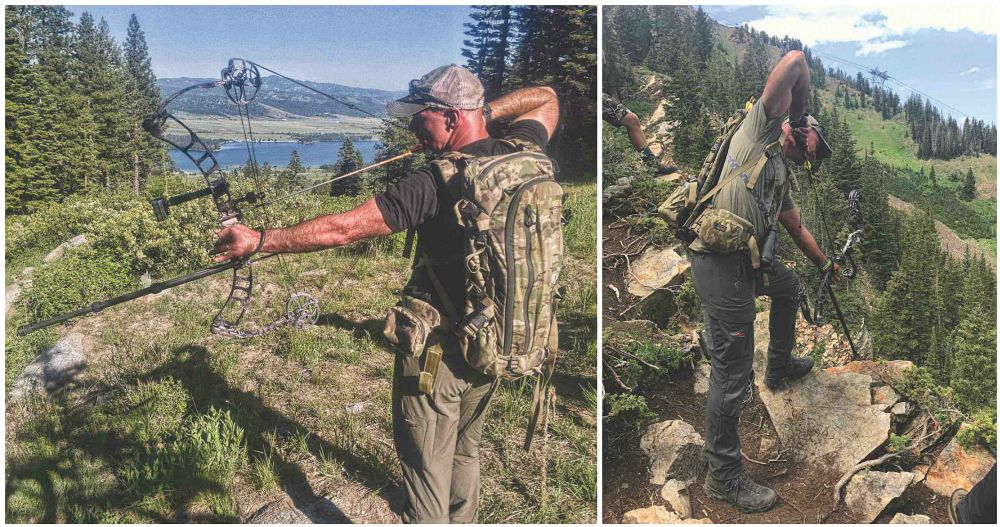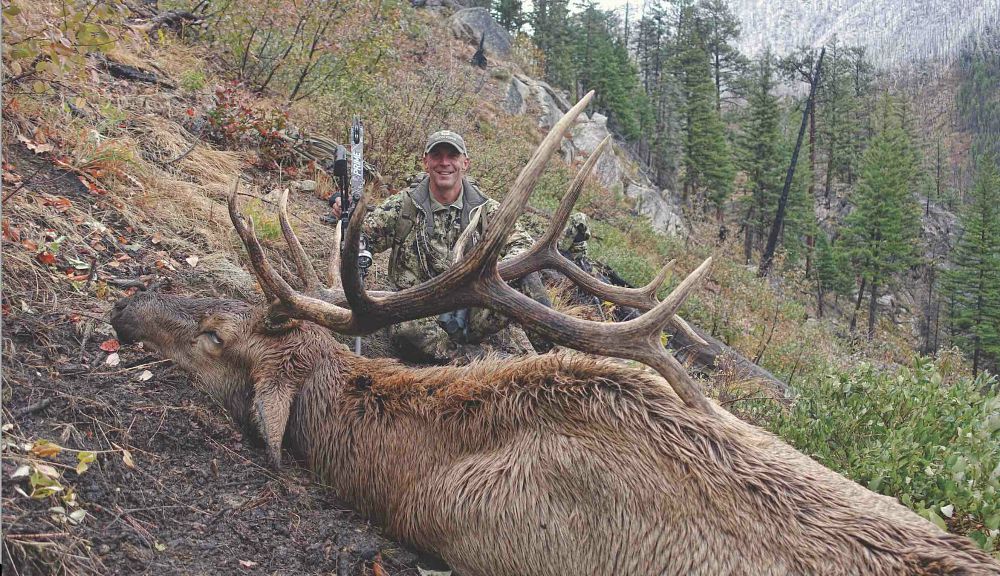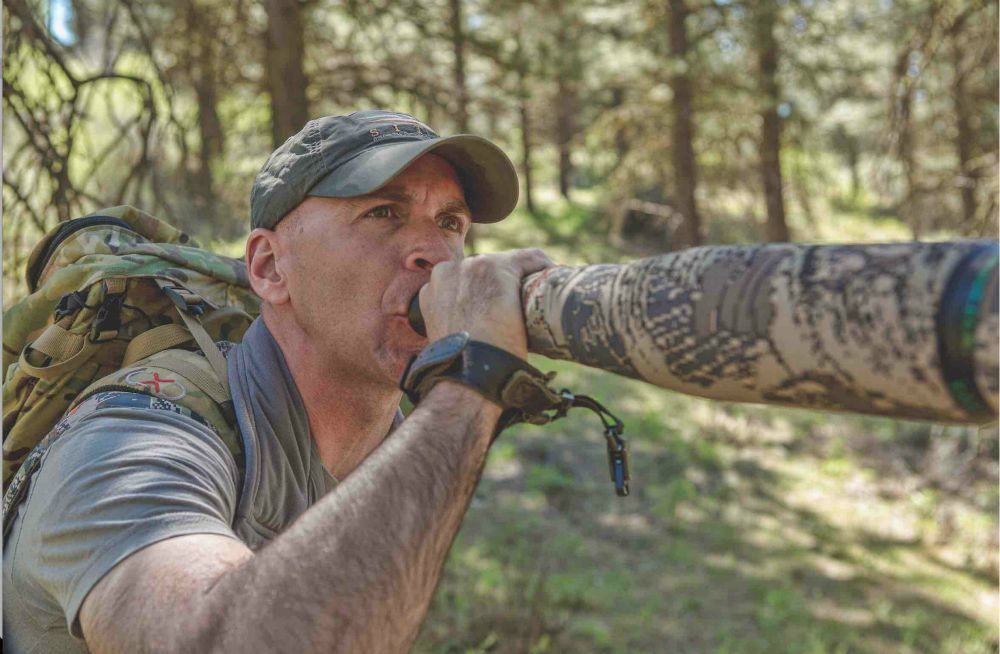Yes, Corey Jacobsen is a 10-time World Champion elk caller. Yes, in 2013, he was named the RMEF’s (Rocky Mountain Elk Foundation) Elk Calling Champion of Champions. Yes, he can do things with a diaphragm call that few in the world can. But I promise you, after spending some quality on-the-phone-time with Corey, his on-the-stage calling accolades don’t define him. Not even a little.
Corey Jacobsen — in the purest sense of the word — is a DIY public-land elk hunter. He, like so many reading this, lives for the preparation and pursuit. In addition to practicing his calling, he spends hours fine-tuning gear, keeping in top physical shape and sending arrows downrange. Because of Corey’s calling accomplishments, I expected he’d jump right in on his “how to call a bull” system. I was wrong. We spent the first 15 minutes of our call discussing the gigantic stabilizer he totes into the field. He loves that thing.
“It just works for me. When I first started using the Crossover Stabilizer, I noticed my groups improved drastically downrange. I’m not a pro shooter by any means, but I feel like I can shoot pretty well, and typically shoot about 6-inch groups out to 60 yards. After I put this stabilizer on my bow, I was touching arrows at 60 yards.
“One would think the 24-inch stabilizer would get hung up in the brush and the like, or be cumbersome to carry. It’s not at all. I’ve been hunting with it for 2 years now, and I’ve never once got hung up or felt the stabilizer hindered my ability to move about efficiently. It rests perfectly right between my backpack and my shoulder blade.”
Yep, that’s what Corey Jacobsen and I talked about first — stabilizers, of all things. Why? Because Corey believes this stabilizer has improved his shooting and boosted his in-the-field success. He was passionate about it, and because it helped him, he wants others to know about it. In my opinion, that’s what he was put on this earth to do — help other bowhunters be successful.

Corey dedicates a ton of time to his pre-season shot routine. He shoots regularly in the environments he plans to bowhunt in, and learns exactly how his equipment will perform.
If you haven’t, take a glance at Corey’s website, www.Elk101.com. The site covers all things elk hunting. There are informative forums and articles, tips, tactics, videos, podcasts and more. It’s a very “elky” place. In addition to the regular elk content on Elk101.com, you can also become a member and enroll in Corey’s University of Elk Hunting Online Course.
“I really feel like this is the most comprehensive elk hunting resource ever,” Corey said. “I wanted to take my 30 years of elk hunting knowledge and use it to help others find success, regardless of their skill level. This course will help those who have never hunted elk, as well as those who manage to drop a bull every single archery season. The course is broken up into 17 Modules and 54 Chapters, and those that enroll will find over 120,000 written words, over 60 video components and hundreds of images and diagrams. There isn’t one single thing I’ve learned while elk hunting that is not in this course.”
“I don’t just want people to go elk hunting — I want people to have success. I hate that success for elk hunters on public land hovers around 10 percent. My goal is to boost that number with the University of Elk Hunting. I’m also putting together three free mini-courses that cover elk hunting for three categories of elk hunters: those who have never hunted elk before but want to, those who have hunted elk before but have never killed one, and the third for those who have killed a handful of elk but can’t find consistency.”
Personally, I plan to take the course that will help me boost my season-to-season consistency in the elk woods, but for this particular piece, Corey and I decided it best to focus on those who have been elk hunting but have never killed one. Why? Both Corey and I felt that the "I’ve been elk hunting for 3 years now on public land and have yet to see a bull," and the, "I’ve been several times but haven’t even heard a bull bugle" emails have been the norm as of late. So here we go.
Finding Elk
“For someone coming out of whitetail country and into elk country, the odds of success are way below 10 percent,” Corey noted. I think this scares so many people off, but honestly, those who have true ambition — willing to work and do whatever it takes to achieve what you want — can forget the odds. Let’s start with that foundation. Realize it’s going to take work.
“When it comes to successful elk hunting, first you need to be able to find elk. Once you locate them, you’re in the game. Of course, hands-on scouting ahead of time is great, but it’s not always feasible. The good news is e-scouting has come so far. I find so many of my elk spots using Google Earth. It’s almost unfair how far technology has come, and I love the challenge of picking spots I’ve never been to before through e-scouting. The cool thing is, because I know what I’m looking for, I’m able to mark-up spots during e-scouting and be totally confident I will go into the area and find elk.
“When I’m e-scouting, I focus my attention on north-facing slopes that are at least a mile from the road. If I can find north-facing slopes away from any vehicle access, I start really honing in. If you think about it, if you’re looking over a big area and focus your search on those north-facing slopes away from vehicle access, you’ll quickly narrow your search. Then, I take those areas we just mentioned and locate food and water sources. This will narrow your search further. The point is, a vast area can become very small, very quickly if you know what you’re looking for. The north-facing slopes represent where the elk are most likely to bed. When it comes to food sources, I like to locate open ridges, open hillsides and clear-cuts. When it comes to water, I simply change the dates on my Google Earth map to September and look for green areas, which tells me there is water in the area in September. Now simply triangulate the areas that have food, water and north-facing slopes. These are the places you will want to explore first once your hunt starts.”
The Corey Jacobsen Wheelhouse
Once Corey finds elk, his plan for calling a bull bowhunting-close is pressed into motion, and though he’s probably better than most when it comes to making realistic elk talk, he firmly believes that anyone can call in elk. This was music to my ears, and his advice really made me change the way I plan to go about calling elk this season. I think it will change yours as well.
“You don’t have to be a great caller to call in elk,” Corey said. “If you’re in an area that holds elk, you have a good chance of calling in a bull. Of course, you don’t want to be walking around blindly in an area that you’re not sure has elk, screaming on your bugle and chirping on your cow calls. The main key to calling in elk is being around them.
"Hit a ridge system, and every single time you come to a vantage point, throw out a location bugle (audio clip below). Anybody in the world can make a location bugle. There is nothing fancy about it. The thing about a location bugle is that it’s just what the name implies. It’s a call used to locate elk. It’s not the call we use to call a bull in.
Once you get a bull to respond to a locater bugle, get as close as possible to that elk before making another elk sound. Get the wind in your face and creep in close. Sometimes close may be 100 yards, and sometimes it may be 300 yards, but use the cover and get as close as possible. If the bull keeps sounding off, it’s a little easier to get close. If he gets quiet, you’ll need to pick a few landmarks and play it a little more cautious as you approach.
“Once you’re close, set up in front of cover. Please don’t set up behind cover; it will usually cost you a shot if you do. Instead, set up in front of cover and pick an area where you have some openings to get an arrow through. Once you are set up, all you want to do now is make a simple cow call or two. If you’ve done your job and got in close, being it’s September and his testosterone is on the rise, the bull will often respond. If he does respond, you need to immediately, and I mean immediately, be ready to hit him with a challenge bugle (below). Personally, I like to cut the bull off before he even finishes his bugle. This is not a timid or weak bugle. Put emotion into the bugle and scream at that bull. Let him know you’re wanting him to come and fight.
“Think about it this way: If you’re 500 feet away from another human and they are badgering you, you’re likely to just walk away. If that same human is up in your face, screaming insults at you, there’s a solid chance you’re going to punch him.”
Sounds simple, doesn’t it? That’s because it is. Corey Jacobsen knows there is a huge difference between the stage and the woods, and in the woods, he prefers to keep it simple and not overthink it. He and his hunting partners follow this same program for any bull they encounter at any point during the season.
“This is how we approach every calling setup. Whether it’s early season or late, a herd bull or a young satellite, we keep it the same. It’s my belief that elk are responding to emotion rather than a certain language. You don’t have to worry about saying the exact right thing at the exact right time. Really, you only need to know how to make three sounds: a location bugle, a simple cow call and a challenge bugle. That’s it.
“Of course, there will be times when that bull doesn’t respond when you get close. Don’t get frustrated. It could be the bull moved off, but more than likely he is still there and just doesn’t respond. Either way, don’t bugle. That’s the last thing you want to do. If you do, you’ve given up the element of surprise. Additionally, you’ve issued the first bugle, which means he may challenge you and then stand his ground and wait for you to come to him.
“Typically, I will sit for a minute and let out two or three cow calls and just listen. There’s a good chance that bull is approaching — he’s just doing it quietly. Listen for his hoof to clunk a log or his rack to hit some limbs. I will cow call every few minutes for a while. Don’t get impatient. If nothing responds, start using your bugle tube and make the cow sounds into it. This will get the cow calls out there a bit farther in case the bull has wandered up the ridge a ways and can’t hear those softer cow calls. If I don’t hear any elk sounds after using the cow call in the bugle tube, then I typically move up to where I last heard the bull, access a vantage point and start the process over.”
I don’t think Corey could’ve simplified or explained the process for finding elk and calling them in any better. He is a bank of elk hunting knowledge, and more importantly, a wonderful man who is dedicated to helping other bowhunters achieve success. In my humble opinion, this industry could use a few more hunters like Corey Jacobsen.

Corey Jacobsen poses with a beautiful public-land bull that fell victim to his tried-and-true calling approach. Get close to the bull. Hit him with a cow call. Challenge him the second he bugles back.
What’s New in Elk:
BOWHUNTING IDAHO ELK — THE TOUGHEST DIY BOWHUNT IN AMERICA?







